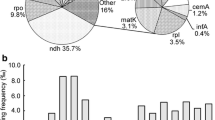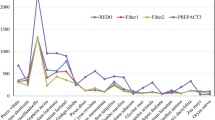Abstract
The ndhB-encoded transcript from barley chloroplasts deviates from the genomic ndhB sequence by nine C-to-U transitions, which is the maximum number of editing events for a chloroplast mRNA reported so far. Comparison with ndhB transcripts from other chloroplast species shows that six of the nine editing sites observed in barley are structurally and functionally conserved in maize, rice and tobacco. The remaining three sites, however, show divergent patterns of conservation even within the three members of the grass family. The conservation of two of these sites in tobacco but not in the closely related graminean species suggests that divergence of the ndhB editing sites is caused by the loss of preexisting editing sites rather than by gain of new sites.
Similar content being viewed by others
References
Hoch B, Maier RM, Appel K, Igloi GL, Kössel H: Editing of a chloroplast mRNA by creation of an initiation codon. Nature 353: 178–180 (1991).
Kössel H, Hoch B, Maier RM, Igloi GL, Kudla J, Zeltz P, Freyer R, Neckermann K, Ruf S: RNA Editing in chloroplasts of higher plants. In: Brennicke A, Kück U (eds), Plant Mitochondria, pp. 93–102. VHC Verlagsgesellschaft, Weinheim (1993).
Maier RM, Neckermann K, Hoch B, Akhmedov NB, Kössel H: Identification of editing positions in the ndhB transcript from maize chloroplasts reveals sequence similarities between editing sites of chloroplasts and plant mitochondria. Nucl Acids Res 20: 6189–6194 (1992).
Robinson C, Barnett LK: Isolation and analysis of chloroplasts. In: Shaw CH (ed), Plant Molecular Biology: A Practical Approach, pp. 67–78. IRL Press, Oxford (1988).
Chirgwin JM, Przybyla AE, MacDonald RJ, Rutter WJ: Isolation of biologically active ribonucleic acid from sources enriched in ribonuclease. Biochemistry 18: 5294–5299 (1979).
Maier RM, Hoch B, Zeltz P, Kössel H: Internal editing of the maize chloroplast ndhA transcript restores codons for conserved amino acids. Plant Cell 4: 609–616 (1992).
Sheen JY, Bogorad L: Differential expression of the ribulose bisphosphat carboxylase large subunit gene in bundle sheath and mesophyll cells of developing maize leaves is influenced by light. Plant Physiol 79: 1072–1076 (1988).
Dellaporta SL, Wood J, Hicks JB: A plant DNA minipreparation: Version II. Plant Mol Biol Rep 1: 19–21 (1983).
Bachmann B, Lüke W, Hunsmann G: Improvement of PCR amplified DNA sequencing with the aid of detergents. Nucl Acids Res 18: 1309 (1990).
Zeltz P, Hess WR, Neckermann K, Börner T, Kössel H: Editing of the chloroplast rpoB transcript is independent of chloroplast translation and shows different patterns in barley and maize. EMBO J 12: 4291–4296 (1993).
Freyer R, Hoch B, Neckermann K, Maier RM, Kössel H: RNA editing in maize chloroplasts is a processing step independent of splicing and cleavage to monocistronic mRNAs. Plant J 4: 621–629 (1993).
Hirose T, Wakasugi T, Sigiura M, Kössel H: RNA editing of tobacco petB mRNAs occurs both in chloroplasts and non-photosynthetic proplastids. Plant Mol Biol 26: 509–513 (1994).
Hiratsuka J, Shimada H, Whittier R, Ishibashi T, Sakamoto M, Mori M, Kondo C, Honji Y, Sun C-R, Meng B-Y, Li Y-Q, Kanno A, Nishizawa Y, Hirai A, Shinozaki K, Sugiura M: The complete sequence of the rice (Oryza sativa) chloroplast genome: Intermolecular recombination between distinct tRNA genes accounts for a major plastid DNA inversion during the evolution of the cereals. Mol Gen Genet 217: 185–194 (1989).
Shinozaki K, Ohme M, Tanaka M, Wakasugi T, Hayashida N, Matsubayashi T, Zaita N, Chunwongse J, Obokata J, Yamaguchi-Shinozaki K, Ohto C, Torazawa K, Meng BY, Sugita M, Deno H, Kamogashira T, Yamada K, Kusuda J, Takaiwa F, Kato A, Tohdoh N, Shimada H, Sugiura M: The complete nucleotide sequence of the tobacco chloroplast genome. Its gene organization and expression, EMBO J 5: 2043–2049 (1986).
Ohyama K, Fukuzawa H, Kochi T, Shira H, Sano T, Umesono K, Shiki Y, Takeuchi M, Chang Z, Aota S, Inokuchi H, Ozeki H: Chloroplast gene organization deduced from complete sequence of liverwort Marchantia polymorpha chloroplast DNA. Nature 322: 572–574 (1986).
Author information
Authors and Affiliations
Rights and permissions
About this article
Cite this article
Freyer, R., López, C., Maier, R.M. et al. Editing of the chloroplast ndhB encoded transcript shows divergence between closely related members of the grass family (Poaceae). Plant Mol Biol 29, 679–684 (1995). https://doi.org/10.1007/BF00041158
Received:
Accepted:
Issue Date:
DOI: https://doi.org/10.1007/BF00041158




